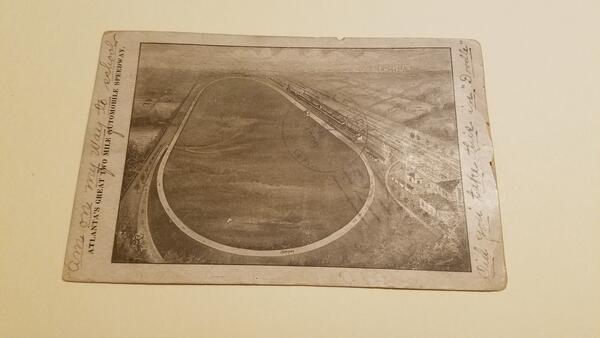- 1890s Cars
- Barney Oldfield Images
- Oldfield - Petersen
- Beer
- Early Auto Industry
- Uniontown - Marci McGuinness
- General Period Clip Art
- Early Race Related Clip Art
- Advertising and Editorial Cartoons
- Early Indianapolis
- IMS Construction
- Indianapolis Speedway
- First IMS Auto Races
- Failed 1909 Air Show
- 1909 IMS Balloon Races
- 1909 IMS Motorcycle Meet
- 1910 Indianapolis Auto Show
- 1913 Indianapolis 500
- 1919 Indianapolis 500
- Joe Dawson
- WWI "500" Winner Draft Cards
- Frank Di Buglione (off the wall art, LLC)
- Gilbert Art
- Carl Graham Fisher
- IMS Hall of Fame Museum
- Alco at 100th Anniversary
- Frederic Matile - Morris Park
- Miami-Fulford Speedway
- Paul Sheedy Collection
- Early Wyoming Racing - 1909 - 1919
- Personalities
- Early Racing Images
- Glidden Tour
- 1909 Cobe Trophy
- Fairmount Park & Belmont Estates
- Early Santa Monica
- Don Radbruch Collection
- Jeroen de Boer Collection 1910
- Jeroen de Boer Collection 1912
- Jeroen de Boer Collection 1913
- Jeroen de Boer Collection 1914
- Georges Boillot
- Story's Indianapolis 500 Cars
- Story's Sports Cars
- Story's Grand Prix Cars
- Old School
- Story's Brickyard Sketchbook
Atlanta Speedway Post Card (Front)
Photo Gallery Categories
Search
Featured Article
Image of The Week

This a 1909 post card of Atlanta Speedway. My guess is that this was an artist's rendering created just before the track was constructed.
In the summer of 1909 a group of Atlanta, Georgia business began quietly purchasing farms seven miles from downtown Atlanta, Georgia in the small community of Hapeville. When completed 290 acres of land and been purchased along with eleven farmhouses and outbuildings. The crops in the field were also purchased.
In late June of 1909, the Atlanta Automobile Association was incorporated under Georgia laws by Asa Candler, Jr. and Asa Candler of the Coca-Cola company, Edward M. Durant, insurance, Forrest and George Adair, real estate, F.J. Coolidge, paint industry and R.J. Irwin. The corporation was capitalized at $250,000. Asa Candler, Jr. was made president and Edward M. Durant secretary. The land was taken over by the Atlanta Automobile Association.
Construction began immediately with a goal of holding the first automobile race in November 1909 to coincide with the Atlanta Automobile Show November 6 – 13 (the first automobile exposition show in the south) to be held in the Atlanta Auditorium Armory and the New York City to Atlanta, New York Herald/Atlanta Journal Good Roads Tour November 1 – 9.
The Atlanta Speedway was constructed as a two-mile oval. The homestretch 100 feet wide, the backstretch and curves 60 feet wide. The curves banked at 10 feet with an 880-foot radius. The surface was a clay, sand, gravel base with a special oil rolled into the track.
Grandstands to accommodate 30,000 spectators, judges and press stands erected on raised banks on each side of the homestretch were built. Bleachers located alongside the big grandstand on a raised bank of 15 feet above the track and a double row of box seats six feet lower than the lowest street. No fences inside or outside of the track will be installed for safety reasons.
Corrugated iron garages (fireproof) located in back of the judges stand each house four cars, two entering the front and two entering the back. Living rooms of the drivers will be above the garages.
That the construction would be completed on time a crew of ten civil engineers, over 1,000 laborers, 500 mules, and horses, three giant steam shovels, carpenters and masons worked three eight hour shifts. The complex included waterworks and a lighting plant.
The track was “scientifically constructed” as to permit of the speed of two miles a minute with “absolutely no dust”. A novel system of oiling the track from a series of hydrants spaced 50 feet apart around the two-mile course. Two miles of piping was installed with sections of hose attached to each hydrant to sprinkle the entire track in less than half an hour. The Standard Oil Company provided the initial oiling of the two-mile surface.
Travel to the Atlanta Speedway was by Stewart Ave. and College Ave. and by the Atlanta and West Point Railroad and the Central of Georgia Railroad and the Georgia Railway and Electric Company. Asa Candler, Jr. and Edward M. Durant debuted the $300,000 ($8,500,000 in 2019 dollars) speedway October 23, 1909, for a test run. Some of the top drivers of the day were invited for the test. Drivers were timed two miles up to 10 miles with most timed for five miles. Barney Oldfield, Benz, .3.52 3-5, George Robertson, Simplex, .4.59 4-5, Charles Basle, Renault, .4.34 4-5, Louis Cliquot, in Asa Candler, Jr. Pope-Toledo, .4.34 3-5, and amateur Edward M. Durant, Renault, .5.00. Ben Kirschner, Darracq, traveled one mile .53.
“Atlanta's New Track” was the headline of the November 11, 1909 issue of The Automobile magazine. “Speed in abundance, no serious accidents” was the opening sentence for the first speed contest of the new Atlanta Speedway Tuesday, November 9 – 13, 1909.
| Attachment | Size |
|---|---|
| AtlantaSpeedway.jpg | 3.05 MB |
